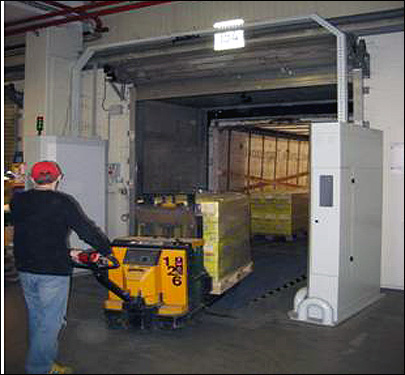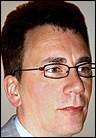German retailer Rewe has moved out of a major testing phase and into day-to-day operations with RFID-tagged pallets at its distribution center in Norderstedt, in northern Germany. Europe’s third-largest food merchant is now focused on expanding the RFID application at its DC so it can receive 3,000 tagged pallets per day. Presently, it receives a total of 200 to 300 tagged pallets daily from roughly 20 different suppliers.
Rewe’s RFID project began in earnest in 2005, though management had discussed it internally as early as 2003. The Norderstedt pilot ran from February to October 2006 with the help of consulting company Kurt Salmon. The companies used the results to calculate a cost-benefit analysis showing Rewe could achieve a return on its investment within two years of going operational.
For the pilot, Rewe constructed six RFID receiving portals, fitted two forklifts with RFID interrogators and tested several handheld readers on 1,500 pallets, to which it attached EPC Class 1 Gen 2 passive UHF tags operating at 868 MHz. By May of this year, the firm intends to expand the application to having 60 RFID receiving portals and 16 RFID-enabled forklifts in operation. The company is also testing about 30 handheld readers. In addition, Rewe has tagged 500 warehouse storage bays so far and is increasing this number to 10,000.
Rewe declines to disclose the identities of the reader manufacturers it used during the pilot, and notes that it is still narrowing its selection of vendors for its planned expansion. The retailer plans to decide on a single vendor to simplify its RFID application by enabling easier software updates on all interrogators, says Jörg Sandlöhken, who works in the company’s internal consulting and risk-management unit.
Rewe worked with its suppliers to link the information on each pallet’s tag with the product records in its IT system, such as product descriptions, the number of boxes on each pallet and receiving orders. Rewe will continue to use EPC Class 1 Gen 2 UHF tags. The system allows the company to exchange order documentation with its suppliers electronically, says Sandlöhken—everything from receiving shipments to the final invoice.
When goods arrive at the distribution center, the driver delivering them unloads the tagged pallets, which are read by a portal interrogator. The information linked to the goods is compared with Rewe’s receiving records, and once a match is made, receipt of the goods is recorded in Rewe’s system.
“Everything happens electronically, “Sandlöhken notes, “when the goods are unloaded.”
Sandlöhken says the pilot showed him that read rates and the technology behind RFID with EPC Class 1 Gen 2 are not the most difficult parts of an application. Rather, the challenge is to integrate everything into existing IT systems so data on dispatch statements can be compared to the information collected by RFID.
“It’s a matter of how you deal with the data,” he says.
Another problem that arose in the pilot involved forklift reading rates, though Sandlöhken says Rewe was able to solve that issue by asking its product suppliers to tag pallets on the middle of one side.
Rewe says it was pleased with the results of the pilot. Presently, the company is experiencing faster receiving with fewer record-keeping errors. Rewe now calculates an 80 percent reduction in the time needed to compare deliveries with orders. Fewer goods are being delivered to the wrong storage bays, thereby spending less time on the warehouse floor, and fewer products are being sent to the wrong retail stores.
Rewe plans to follow up the expansion of RFID at the Norderstedt DC with case-level tests and other trials, though a specific time frame has not yet been set. “We’re missing some standards [regarding case-level tagging] —for instance, with the process. Where should the cases be tagged? When should they be read? And what do you do when you have different articles in each case?” ,” he explains.
Rewe Group’s management has not yet decided if it will roll out RFID in the other divisions it operates in 14 European countries. The group employs 260,000 people and reported sales of about 42 billion euros in 2005.
ROI Calculator
To develop a cost-benefit analysis for its RFID deployment, Rewe used an Excel-based return-on-investment (ROI) calculator created by IBM Germany for the retail/CPG market. IBM often uses the RFID ROI business case calculator internally as part of its consulting services. However, together with EPCglobal member organization GS1 Germany, the company has been selling the software as a stand-alone calculator. The idea for the calculator originated with GS1 in 2004, and the software was completed at the beginning of 2005. Companies participating in the development included Nestlé, Johnson & Johnson and Unilever.
Rewe bought a single license for the software, along with one day of training. Sandlöhken says the calculator helped his company see that a positive ROI could be achieved in a shorter period than it had previously imagined. At the same time, the software has provided Rewe with a better understanding of the impact of RFID applications—i.e., ongoing costs and recurring investments needed. Rewe Group continues to use it to analyze potential projects.
IBM’s initial goal was to use the ROI calculator for its own consulting purposes, says Werner Klein, managing consultant for supply chain management and RFID at IBM Global Business Services. However, the firm decided to sell the software separately, and at a low price, to generate additional revenue and lure in small companies that might need help on their RFID projects. Klein adds that most companies have found the software to be user-friendly and useful for evaluating scenarios utilizing RFID to track pallets or cases.
Although users can run their own calculations with the software and make business decisions based on those calculations, Klein says some users might not have the market overview necessary to select the relevant processes, define all the components of the best-of-breed RFID solution and calculate all the investments and operating costs.
The calculator features a navigation bar, color coding and standardized output calculations. Most of the variables are static—for example, changes in price over time aren’t reflected—but the program does allow for users to choose from three tag-price scenarios: neutral, optimistic or pessimistic. A user expecting prices to drop substantially and quickly, for example, would select optimistic.
Though the software was first developed for the retail and consumer goods industry, a version was also created for the fashion industry. This version allows users to create scenarios of RFID tracking at the item level. Available in German and English from IBM Germany, the software can be converted to calculate in both U.S. dollars and euros.



